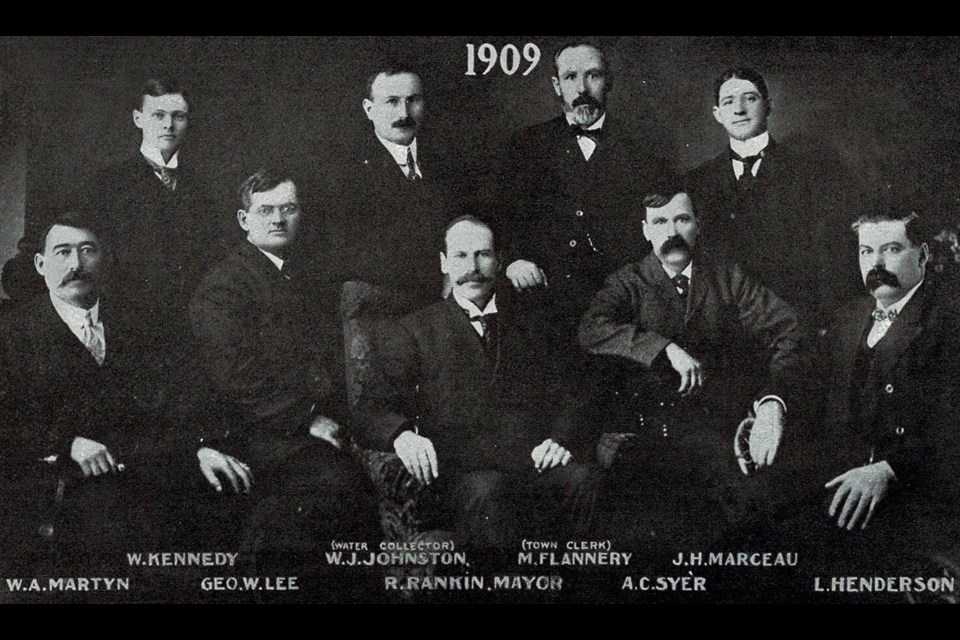North Bay history has been well-documented in a variety of books and the archived works should come in handy as the Centennial Celebration rolls through 2025.
While the city is marking its 100th birthday of incorporation, with provincial legislation passed on April 14, 1925, keep in mind the town of North Bay was founded in 1882.
The Best of Hartley Trussler North Bay, published by the North Bay and District Chamber of Commerce was edited by Michael Barnes in 1982 (the Village of North Bay’s Centennial). It is an excellent place to start a historical journey.
It can be fun digging into the past and finding out how many of the families in the area are connected with long and tangled roots. There are also some neat parallels and alliteration with some of the names and their type of industry.
For example, William A. Milne Sr. built a sawmill on Trout Lake at Delaney Bay at the turn of the century and Charles Coleman was partners in a coal company. Trussler wrote about how the senior William Milne was on the town council from 1904 through 1906 before mayoral duties in 1907.
William (Bill) Jr. was also on council during his day and Don Milne was on council in 1945.
“The six lovely Milne girls married North Bay men,” Trussler wrote in a series of newspaper columns about the city’s historical people. Mrs. Prest, Mrs. Coleman, Mrs. Geo. McDonald, Mrs. Bell, Mrs. H. Anderson and Mrs. Weeks. Mrs. Coleman operated the Coleman and Prest Coal Co. for many years after Charles Coleman died.
There were many notable military veterans from the city who served in the Great Wars and helped shape the community.
“Bill, Colonel Milne, was very active in the Canadian militia in both great wars and received the rank of Colonel and the OB medal for meritorious service. Don was one of the founders of the Pinewood Village and the Northland Trust (later the Ontario Trust Corp.”
Several families can trace their family lineage right back to the town’s first decade, such as the Martyns with W.A. (Bill) and F.J. (Fred) arriving in 1888. Bill was a carpenter and builder, and many of his creations have become iconic heritage sites and remain standing to this day. Fred was into the hardware business, and it was customary for such stores to offer undertaking services at the same time.
“The F.J. Martyn Funeral Home became the leading funeral parlor in town. It is one of the few pioneer businesses still operated by the original family,” Trussler wrote, a statement that remains true more than 40 years later.
Other must-reads include Nipissing from Brule to Booth, by Murray Leatherdale, and also published by the NBDCC in 1975 (North Bay’s 50th anniversary). And W.K.P. Kennedy’s North Bay: Past, Present and Perspective is a gold mine of council minutes and activities, as well as earlier history.
For the year 1925, Kennedy noted the elected officials and the vote count for bylaws the citizens could vote on (a type of governance by the people no longer in vogue for some reason). J.H. McDonald was mayor with councillors: R.Y. Angus, W. Dreany, D.J. Morland, J. McColeman, W. Rayner, R. Rowe, L.H. Saunders, D.G. Stevens and M.J. Wallace.
Vote on By Laws: Change of election date – 1516 For, Against 568; Market – For 570, Against 680; Park – For 380, Against 855.
Elected to the Board of Health: T. H. Lavery, W.D. Parks, M.J. McGuinty.
The plebiscites continued in 1954 when Merle Dickerson was mayor and they were deciding to build a Memorial Rink on Chippewa Street. The Ontario Municipal Board approved a capital expenditure of $400,000. It wasn’t long before the estimated cost was $485,000 and it was noted that ratepayers were needed to vote on $235,000 of additional expenditures for the community building (For 1,872; Against 1,519).
Interestingly, council minutes noted congratulations for former alderman Saunders, mentioned above on the 1925 council, who was elected mayor of Toronto.
By the time the dust settled, the contract for the new memorial building was given to the Foundation Company of Canada at $519,826. And in 1955, they realized another $79,540 was needed to complete the equipment for the rink.
Also that year, the Collegiate Institute Board asked for 10 acres of land at the Chippewa Barracks for a new secondary school.
Next month in the Then and Now series, one of the biggest decisions North Bay made will be featured with details of the annexation/amalgamation of Widdifield and West Ferris townships. It made North Bay the largest municipality in Canada (by acreage) and more than doubled the population.
Also to be included will be excerpts from Michael Barnes's 1982 book Gateway City: The North Bay Story, another NBDCC publication.


